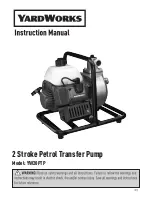
819.0254
5
Installation
General Information
•
The Typical Installations shown in Fig. 2 to Fig. 4 are
only guides for selecting and installing system
components. Contact your VERDER distributor for
assistance in planning a system to suit your needs.
•
Reference numbers and letters in parentheses refer
to the callouts in the figures and the parts lists on
pages 23 to 24.
•
Installation and use must be in accordance with the
Flammable and Combustible Liquids Code (NFPA
30) and Automotive and Marine Service Station Code
(NFPA 30A) and must comply with all local, state,
and federal codes.
•
All pipe joints are to be made tight with UL listed
gasoline-resistant pipe compound.
Tightening Screws Before First Use
Before using the pump for the first time, check and
retorque all external fasteners. See Torque Sequence on
page 25. After the first day of operation, retorque the
fasteners. Although pump use varies, a general guideline
is to retorque fasteners every two months.
Grounding
•
Pump: loosen the grounding screw (W). Insert one
end of a 12 ga (1.5 mm
2
) minimum ground wire (Y)
behind the grounding screw and tighten the screw
securely. See Fig. 1. Connect the clamp end of the
ground wire to a true earth ground. Order Part No.
819.0157 Ground Wire and Clamp.
•
Air and fluid hoses: use only grounded hoses with a
maximum of 500 ft (150 m) combined hose length to
ensure grounding continuity.
•
Air compressor: follow manufacturer’s
recommendations.
•
Solvent pails: Ground all solvent pails used when
flushing, according to local code. Use only metal
pails, which are conductive. Do not place the pail on
a non-conductive surface, such as paper or
cardboard, which interrupts the grounding continuity.
•
Fluid supply container: ground according to local
code.
•
Suction device nozzle: must be bonded to metal
container from which it is suctioning by firm
metalto-metal contact to a properly grounded suction
hose and pump.
•
Piping, valves, and fittings: use only electrically
conductive materials. Bond and ground per code.
Check your system electrical continuity after the initial
installation, and then set up a regular schedule for
checking continuity to be sure proper grounding is
maintained.
Fig. 1
WARNING
FIRE AND EXPLOSION HAZARD
Before operating the pump, ground the
system as explained below. Also read the
section FIRE AND EXPLOSION HAZARD
on page 4.






































